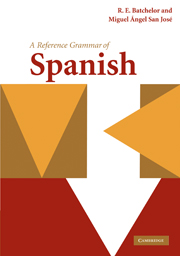Book contents
- Frontmatter
- Contents
- Preface/Prólogo
- Acknowledgments/Agradecimientos
- Abbreviations/Abreviaturas
- Introduction to the Spanish language/Introducción a la lengua española
- Part I
- Part II
- Part III
- Part IV
- Part V
- Part VI
- Part VII
- Part VIII
- Part IX
- Part X
- 76 Names of countries, regions, US states, continents, oceans, rivers, mountains, volcanoes/Nombres de países, regiones, estados de los EE.UU., continentes, océanos, ríos, montañas, volcanes
- 77 Proper names/Nombres propios
- 78 Foreign and indigenous words/Palabras extranjeras e indígenas
- 79 Incorrect use of “la”/“le”/“lo”/Uso incorrecto de “la”/“le”/“lo” (laísmo, leísmo, loísmo)
- 80 Incorrect use of “de” and “que”/Uso incorrecto de “de” y “que” (dequeísmo, queísmo)
- Appendix I Verb tables/ Tablas de verbos
- Appendix II Glossary/Glosario
- Bibliography/Bibliografía
- General index/Índice general
- Subjunctive index/Índice del subjuntivo
76 - Names of countries, regions, US states, continents, oceans, rivers, mountains, volcanoes/Nombres de países, regiones, estados de los EE.UU., continentes, océanos, ríos, montañas, volcanes
from Part X
Published online by Cambridge University Press: 05 June 2012
- Frontmatter
- Contents
- Preface/Prólogo
- Acknowledgments/Agradecimientos
- Abbreviations/Abreviaturas
- Introduction to the Spanish language/Introducción a la lengua española
- Part I
- Part II
- Part III
- Part IV
- Part V
- Part VI
- Part VII
- Part VIII
- Part IX
- Part X
- 76 Names of countries, regions, US states, continents, oceans, rivers, mountains, volcanoes/Nombres de países, regiones, estados de los EE.UU., continentes, océanos, ríos, montañas, volcanes
- 77 Proper names/Nombres propios
- 78 Foreign and indigenous words/Palabras extranjeras e indígenas
- 79 Incorrect use of “la”/“le”/“lo”/Uso incorrecto de “la”/“le”/“lo” (laísmo, leísmo, loísmo)
- 80 Incorrect use of “de” and “que”/Uso incorrecto de “de” y “que” (dequeísmo, queísmo)
- Appendix I Verb tables/ Tablas de verbos
- Appendix II Glossary/Glosario
- Bibliography/Bibliografía
- General index/Índice general
- Subjunctive index/Índice del subjuntivo
Summary
Gender
There is no sure way of establishing any logical pattern for the gender of countries. About 60 percent of countries are feminine and the rest are masculine. The only helpful way of remembering gender associated with a country, or region, is to link the definite article with that country when it first appears. Note that countries, regions, towns, rivers, oceans, mountains, and so on, appear with upper-case letters, while inhabitants of countries, towns, and so on (gentilicios), have lower case (as in other Romance languages). It should be pointed out that (again in keeping with usage in these other cognate languages) names of inhabitants of towns, and even very small villages, are most common, as opposed to usage in English-speaking countries. Sometimes, the gentilicio seems to lack any correspondence with the town or village it describes. This is often due to a return to Latin etymological roots: regiomontano (of Monterrey) is of Latin provenance. Other factors sometimes come into play, as with San Sebastián in the Basque country, where donostiarra is directly connected to the Basque word.
Unfortunately, in general discourse, the vast majority of countries do not take the definite article unless they are qualified by an adjective or an adjectival phrase, and this causes some difficulty in remembering the gender. However, this problem should not be exaggerated.
Gender is given below with each country or region as it is listed.
- Type
- Chapter
- Information
- A Reference Grammar of Spanish , pp. 459 - 466Publisher: Cambridge University PressPrint publication year: 2010



